Analysis of FLSA Compliance, Exemptions, and Case Studies: A Report
VerifiedAdded on 2022/12/15
|7
|2125
|376
Report
AI Summary
This report analyzes the Fair Labor Standards Act (FLSA) compliance within a hypothetical company, focusing on overtime pay and exemptions. It identifies potential violations of the FLSA, highlighting the company's failure to compensate employees for overtime work and lack of understanding of the act. The report delves into the classification of employees, distinguishing between exempt and nonexempt status, and emphasizes the importance of proper record-keeping. The report further examines the financial and legal implications of non-compliance, including potential lawsuits and economic losses, by referencing case studies like Starbucks and Uber. It also includes a discussion on Ms. O'Neil's exemption status, and provides a detailed bibliography. The report underscores the importance of adhering to FLSA guidelines to avoid legal repercussions and maintain a fair work environment.
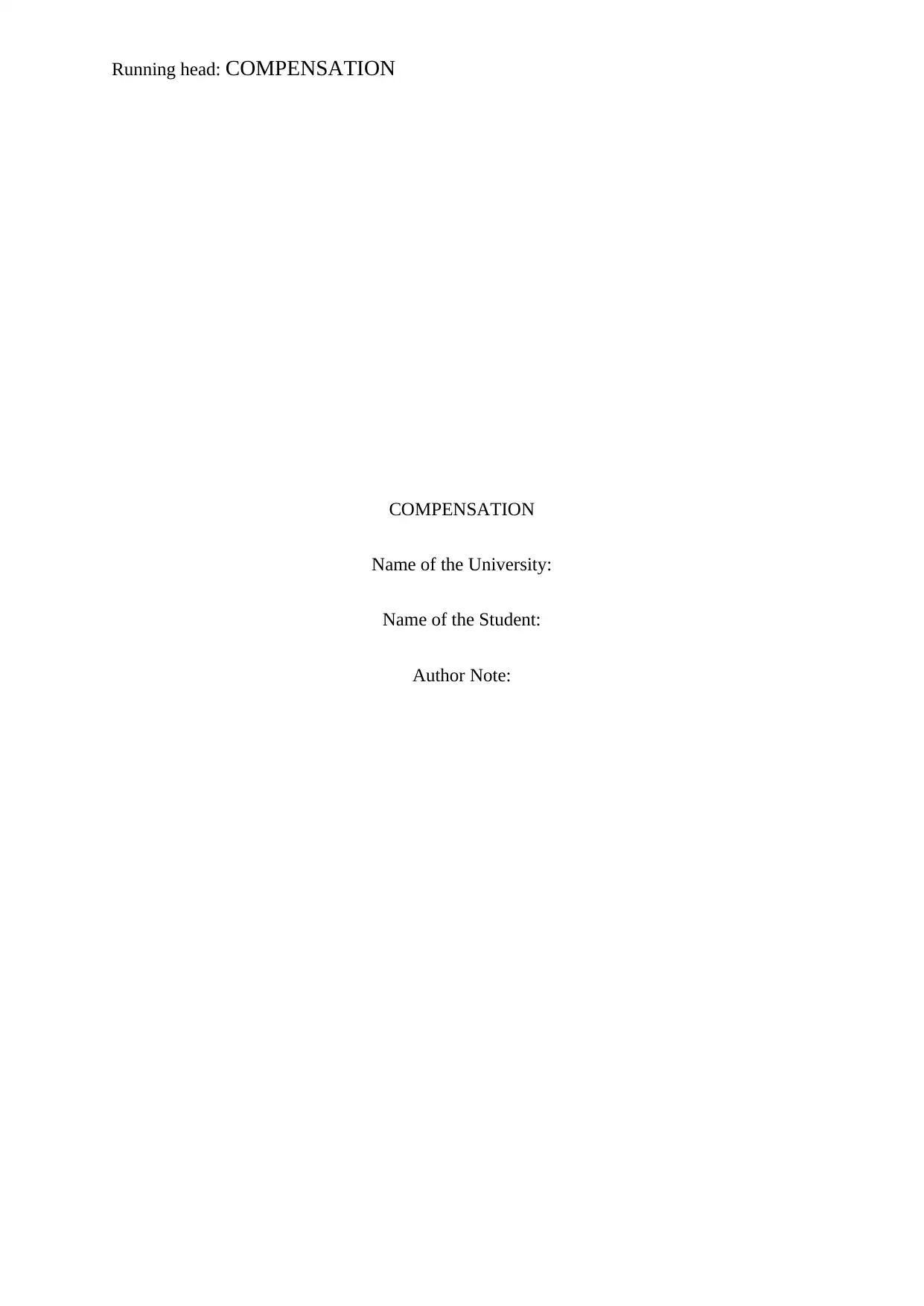
Running head: COMPENSATION
COMPENSATION
Name of the University:
Name of the Student:
Author Note:
COMPENSATION
Name of the University:
Name of the Student:
Author Note:
Paraphrase This Document
Need a fresh take? Get an instant paraphrase of this document with our AI Paraphraser
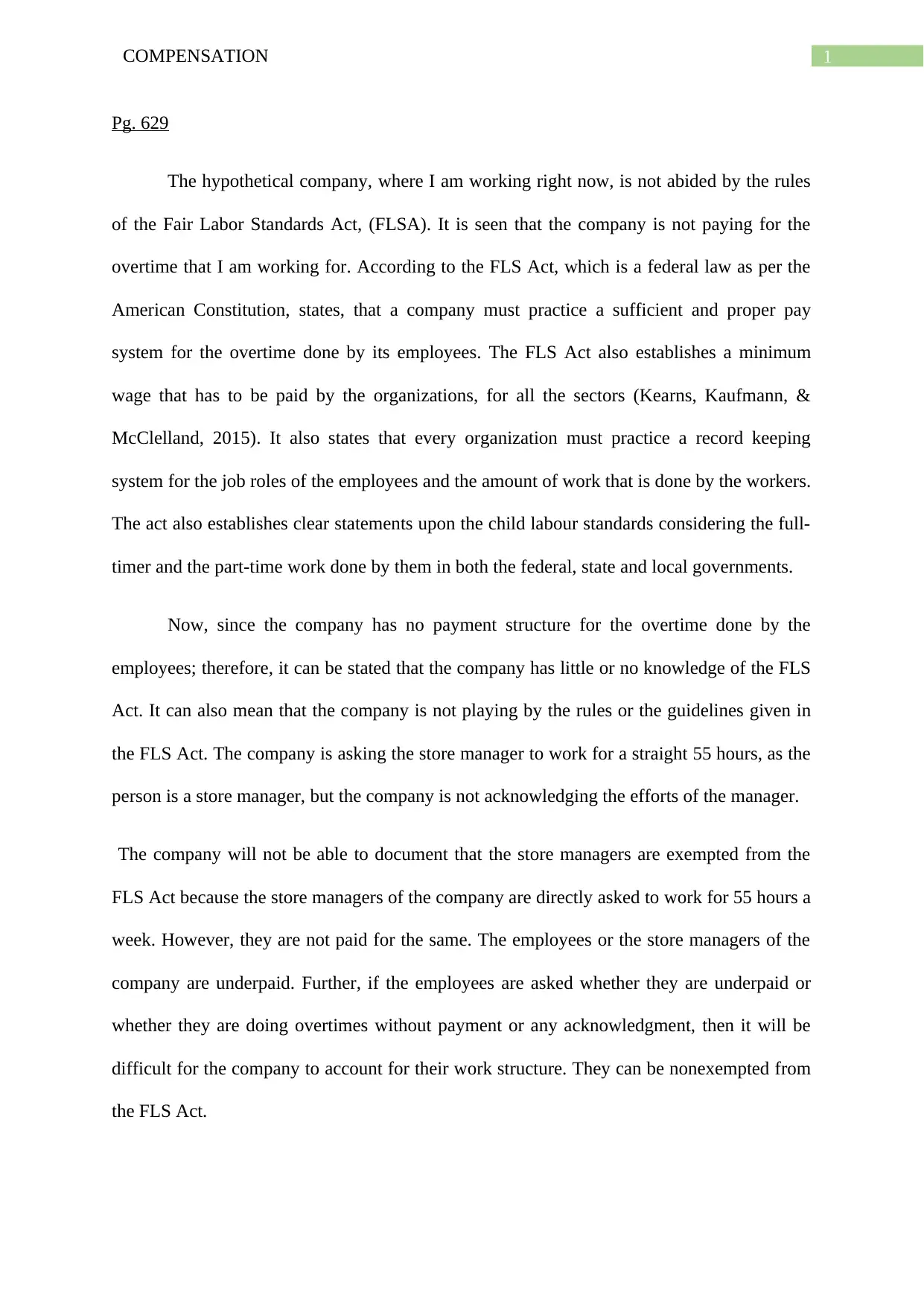
1COMPENSATION
Pg. 629
The hypothetical company, where I am working right now, is not abided by the rules
of the Fair Labor Standards Act, (FLSA). It is seen that the company is not paying for the
overtime that I am working for. According to the FLS Act, which is a federal law as per the
American Constitution, states, that a company must practice a sufficient and proper pay
system for the overtime done by its employees. The FLS Act also establishes a minimum
wage that has to be paid by the organizations, for all the sectors (Kearns, Kaufmann, &
McClelland, 2015). It also states that every organization must practice a record keeping
system for the job roles of the employees and the amount of work that is done by the workers.
The act also establishes clear statements upon the child labour standards considering the full-
timer and the part-time work done by them in both the federal, state and local governments.
Now, since the company has no payment structure for the overtime done by the
employees; therefore, it can be stated that the company has little or no knowledge of the FLS
Act. It can also mean that the company is not playing by the rules or the guidelines given in
the FLS Act. The company is asking the store manager to work for a straight 55 hours, as the
person is a store manager, but the company is not acknowledging the efforts of the manager.
The company will not be able to document that the store managers are exempted from the
FLS Act because the store managers of the company are directly asked to work for 55 hours a
week. However, they are not paid for the same. The employees or the store managers of the
company are underpaid. Further, if the employees are asked whether they are underpaid or
whether they are doing overtimes without payment or any acknowledgment, then it will be
difficult for the company to account for their work structure. They can be nonexempted from
the FLS Act.
Pg. 629
The hypothetical company, where I am working right now, is not abided by the rules
of the Fair Labor Standards Act, (FLSA). It is seen that the company is not paying for the
overtime that I am working for. According to the FLS Act, which is a federal law as per the
American Constitution, states, that a company must practice a sufficient and proper pay
system for the overtime done by its employees. The FLS Act also establishes a minimum
wage that has to be paid by the organizations, for all the sectors (Kearns, Kaufmann, &
McClelland, 2015). It also states that every organization must practice a record keeping
system for the job roles of the employees and the amount of work that is done by the workers.
The act also establishes clear statements upon the child labour standards considering the full-
timer and the part-time work done by them in both the federal, state and local governments.
Now, since the company has no payment structure for the overtime done by the
employees; therefore, it can be stated that the company has little or no knowledge of the FLS
Act. It can also mean that the company is not playing by the rules or the guidelines given in
the FLS Act. The company is asking the store manager to work for a straight 55 hours, as the
person is a store manager, but the company is not acknowledging the efforts of the manager.
The company will not be able to document that the store managers are exempted from the
FLS Act because the store managers of the company are directly asked to work for 55 hours a
week. However, they are not paid for the same. The employees or the store managers of the
company are underpaid. Further, if the employees are asked whether they are underpaid or
whether they are doing overtimes without payment or any acknowledgment, then it will be
difficult for the company to account for their work structure. They can be nonexempted from
the FLS Act.
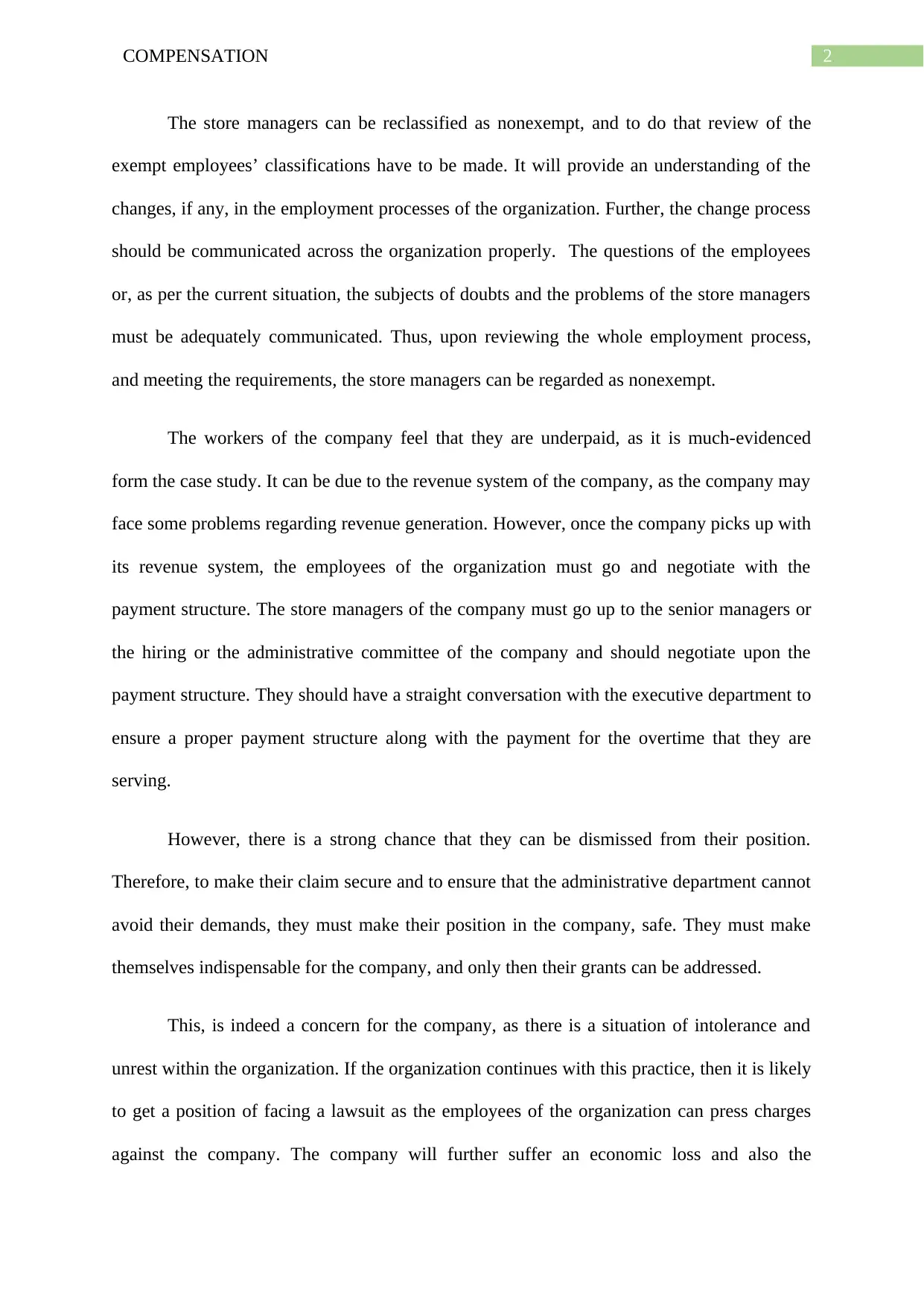
2COMPENSATION
The store managers can be reclassified as nonexempt, and to do that review of the
exempt employees’ classifications have to be made. It will provide an understanding of the
changes, if any, in the employment processes of the organization. Further, the change process
should be communicated across the organization properly. The questions of the employees
or, as per the current situation, the subjects of doubts and the problems of the store managers
must be adequately communicated. Thus, upon reviewing the whole employment process,
and meeting the requirements, the store managers can be regarded as nonexempt.
The workers of the company feel that they are underpaid, as it is much-evidenced
form the case study. It can be due to the revenue system of the company, as the company may
face some problems regarding revenue generation. However, once the company picks up with
its revenue system, the employees of the organization must go and negotiate with the
payment structure. The store managers of the company must go up to the senior managers or
the hiring or the administrative committee of the company and should negotiate upon the
payment structure. They should have a straight conversation with the executive department to
ensure a proper payment structure along with the payment for the overtime that they are
serving.
However, there is a strong chance that they can be dismissed from their position.
Therefore, to make their claim secure and to ensure that the administrative department cannot
avoid their demands, they must make their position in the company, safe. They must make
themselves indispensable for the company, and only then their grants can be addressed.
This, is indeed a concern for the company, as there is a situation of intolerance and
unrest within the organization. If the organization continues with this practice, then it is likely
to get a position of facing a lawsuit as the employees of the organization can press charges
against the company. The company will further suffer an economic loss and also the
The store managers can be reclassified as nonexempt, and to do that review of the
exempt employees’ classifications have to be made. It will provide an understanding of the
changes, if any, in the employment processes of the organization. Further, the change process
should be communicated across the organization properly. The questions of the employees
or, as per the current situation, the subjects of doubts and the problems of the store managers
must be adequately communicated. Thus, upon reviewing the whole employment process,
and meeting the requirements, the store managers can be regarded as nonexempt.
The workers of the company feel that they are underpaid, as it is much-evidenced
form the case study. It can be due to the revenue system of the company, as the company may
face some problems regarding revenue generation. However, once the company picks up with
its revenue system, the employees of the organization must go and negotiate with the
payment structure. The store managers of the company must go up to the senior managers or
the hiring or the administrative committee of the company and should negotiate upon the
payment structure. They should have a straight conversation with the executive department to
ensure a proper payment structure along with the payment for the overtime that they are
serving.
However, there is a strong chance that they can be dismissed from their position.
Therefore, to make their claim secure and to ensure that the administrative department cannot
avoid their demands, they must make their position in the company, safe. They must make
themselves indispensable for the company, and only then their grants can be addressed.
This, is indeed a concern for the company, as there is a situation of intolerance and
unrest within the organization. If the organization continues with this practice, then it is likely
to get a position of facing a lawsuit as the employees of the organization can press charges
against the company. The company will further suffer an economic loss and also the
⊘ This is a preview!⊘
Do you want full access?
Subscribe today to unlock all pages.

Trusted by 1+ million students worldwide
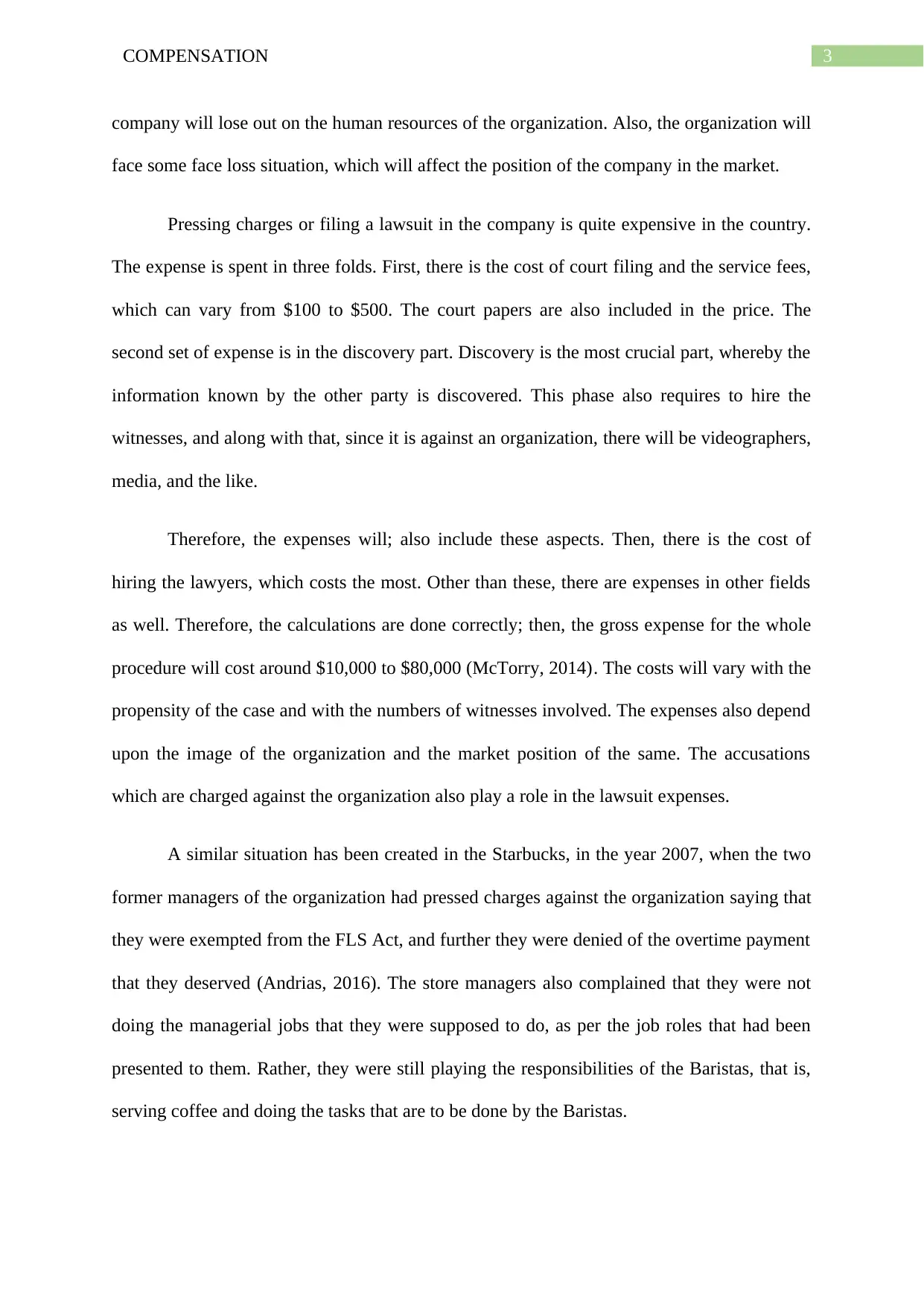
3COMPENSATION
company will lose out on the human resources of the organization. Also, the organization will
face some face loss situation, which will affect the position of the company in the market.
Pressing charges or filing a lawsuit in the company is quite expensive in the country.
The expense is spent in three folds. First, there is the cost of court filing and the service fees,
which can vary from $100 to $500. The court papers are also included in the price. The
second set of expense is in the discovery part. Discovery is the most crucial part, whereby the
information known by the other party is discovered. This phase also requires to hire the
witnesses, and along with that, since it is against an organization, there will be videographers,
media, and the like.
Therefore, the expenses will; also include these aspects. Then, there is the cost of
hiring the lawyers, which costs the most. Other than these, there are expenses in other fields
as well. Therefore, the calculations are done correctly; then, the gross expense for the whole
procedure will cost around $10,000 to $80,000 (McTorry, 2014). The costs will vary with the
propensity of the case and with the numbers of witnesses involved. The expenses also depend
upon the image of the organization and the market position of the same. The accusations
which are charged against the organization also play a role in the lawsuit expenses.
A similar situation has been created in the Starbucks, in the year 2007, when the two
former managers of the organization had pressed charges against the organization saying that
they were exempted from the FLS Act, and further they were denied of the overtime payment
that they deserved (Andrias, 2016). The store managers also complained that they were not
doing the managerial jobs that they were supposed to do, as per the job roles that had been
presented to them. Rather, they were still playing the responsibilities of the Baristas, that is,
serving coffee and doing the tasks that are to be done by the Baristas.
company will lose out on the human resources of the organization. Also, the organization will
face some face loss situation, which will affect the position of the company in the market.
Pressing charges or filing a lawsuit in the company is quite expensive in the country.
The expense is spent in three folds. First, there is the cost of court filing and the service fees,
which can vary from $100 to $500. The court papers are also included in the price. The
second set of expense is in the discovery part. Discovery is the most crucial part, whereby the
information known by the other party is discovered. This phase also requires to hire the
witnesses, and along with that, since it is against an organization, there will be videographers,
media, and the like.
Therefore, the expenses will; also include these aspects. Then, there is the cost of
hiring the lawyers, which costs the most. Other than these, there are expenses in other fields
as well. Therefore, the calculations are done correctly; then, the gross expense for the whole
procedure will cost around $10,000 to $80,000 (McTorry, 2014). The costs will vary with the
propensity of the case and with the numbers of witnesses involved. The expenses also depend
upon the image of the organization and the market position of the same. The accusations
which are charged against the organization also play a role in the lawsuit expenses.
A similar situation has been created in the Starbucks, in the year 2007, when the two
former managers of the organization had pressed charges against the organization saying that
they were exempted from the FLS Act, and further they were denied of the overtime payment
that they deserved (Andrias, 2016). The store managers also complained that they were not
doing the managerial jobs that they were supposed to do, as per the job roles that had been
presented to them. Rather, they were still playing the responsibilities of the Baristas, that is,
serving coffee and doing the tasks that are to be done by the Baristas.
Paraphrase This Document
Need a fresh take? Get an instant paraphrase of this document with our AI Paraphraser
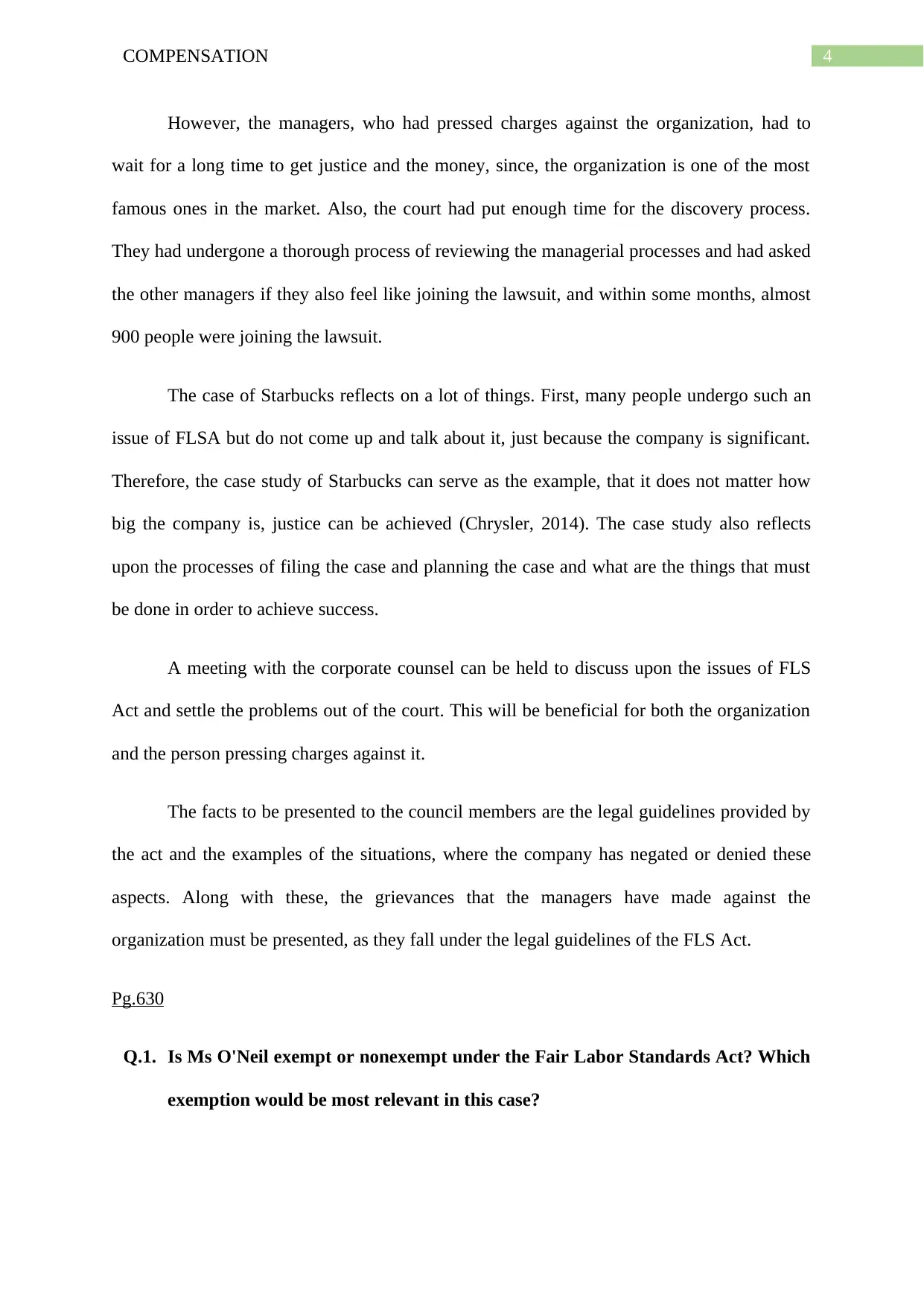
4COMPENSATION
However, the managers, who had pressed charges against the organization, had to
wait for a long time to get justice and the money, since, the organization is one of the most
famous ones in the market. Also, the court had put enough time for the discovery process.
They had undergone a thorough process of reviewing the managerial processes and had asked
the other managers if they also feel like joining the lawsuit, and within some months, almost
900 people were joining the lawsuit.
The case of Starbucks reflects on a lot of things. First, many people undergo such an
issue of FLSA but do not come up and talk about it, just because the company is significant.
Therefore, the case study of Starbucks can serve as the example, that it does not matter how
big the company is, justice can be achieved (Chrysler, 2014). The case study also reflects
upon the processes of filing the case and planning the case and what are the things that must
be done in order to achieve success.
A meeting with the corporate counsel can be held to discuss upon the issues of FLS
Act and settle the problems out of the court. This will be beneficial for both the organization
and the person pressing charges against it.
The facts to be presented to the council members are the legal guidelines provided by
the act and the examples of the situations, where the company has negated or denied these
aspects. Along with these, the grievances that the managers have made against the
organization must be presented, as they fall under the legal guidelines of the FLS Act.
Pg.630
Q.1. Is Ms O'Neil exempt or nonexempt under the Fair Labor Standards Act? Which
exemption would be most relevant in this case?
However, the managers, who had pressed charges against the organization, had to
wait for a long time to get justice and the money, since, the organization is one of the most
famous ones in the market. Also, the court had put enough time for the discovery process.
They had undergone a thorough process of reviewing the managerial processes and had asked
the other managers if they also feel like joining the lawsuit, and within some months, almost
900 people were joining the lawsuit.
The case of Starbucks reflects on a lot of things. First, many people undergo such an
issue of FLSA but do not come up and talk about it, just because the company is significant.
Therefore, the case study of Starbucks can serve as the example, that it does not matter how
big the company is, justice can be achieved (Chrysler, 2014). The case study also reflects
upon the processes of filing the case and planning the case and what are the things that must
be done in order to achieve success.
A meeting with the corporate counsel can be held to discuss upon the issues of FLS
Act and settle the problems out of the court. This will be beneficial for both the organization
and the person pressing charges against it.
The facts to be presented to the council members are the legal guidelines provided by
the act and the examples of the situations, where the company has negated or denied these
aspects. Along with these, the grievances that the managers have made against the
organization must be presented, as they fall under the legal guidelines of the FLS Act.
Pg.630
Q.1. Is Ms O'Neil exempt or nonexempt under the Fair Labor Standards Act? Which
exemption would be most relevant in this case?
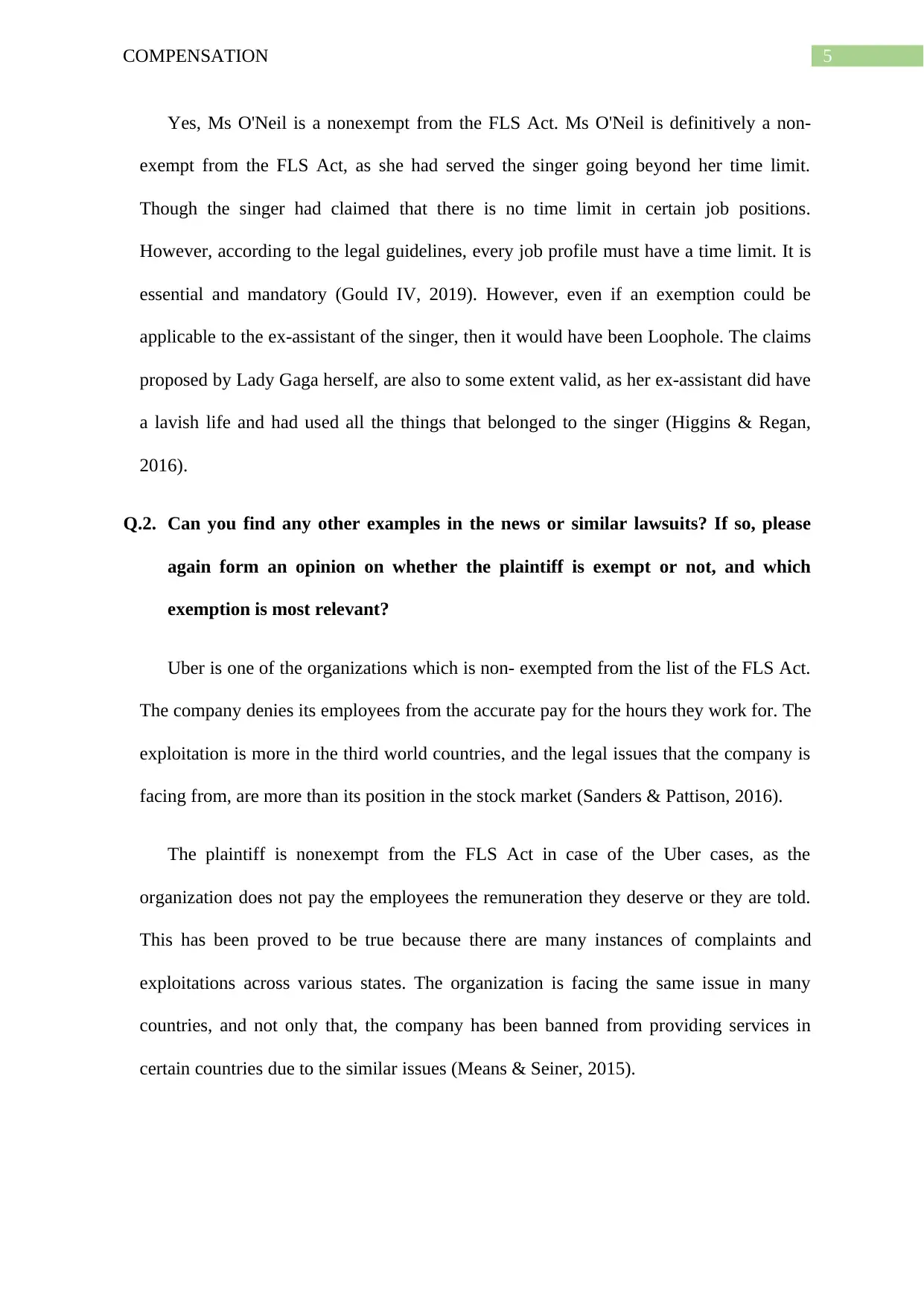
5COMPENSATION
Yes, Ms O'Neil is a nonexempt from the FLS Act. Ms O'Neil is definitively a non-
exempt from the FLS Act, as she had served the singer going beyond her time limit.
Though the singer had claimed that there is no time limit in certain job positions.
However, according to the legal guidelines, every job profile must have a time limit. It is
essential and mandatory (Gould IV, 2019). However, even if an exemption could be
applicable to the ex-assistant of the singer, then it would have been Loophole. The claims
proposed by Lady Gaga herself, are also to some extent valid, as her ex-assistant did have
a lavish life and had used all the things that belonged to the singer (Higgins & Regan,
2016).
Q.2. Can you find any other examples in the news or similar lawsuits? If so, please
again form an opinion on whether the plaintiff is exempt or not, and which
exemption is most relevant?
Uber is one of the organizations which is non- exempted from the list of the FLS Act.
The company denies its employees from the accurate pay for the hours they work for. The
exploitation is more in the third world countries, and the legal issues that the company is
facing from, are more than its position in the stock market (Sanders & Pattison, 2016).
The plaintiff is nonexempt from the FLS Act in case of the Uber cases, as the
organization does not pay the employees the remuneration they deserve or they are told.
This has been proved to be true because there are many instances of complaints and
exploitations across various states. The organization is facing the same issue in many
countries, and not only that, the company has been banned from providing services in
certain countries due to the similar issues (Means & Seiner, 2015).
Yes, Ms O'Neil is a nonexempt from the FLS Act. Ms O'Neil is definitively a non-
exempt from the FLS Act, as she had served the singer going beyond her time limit.
Though the singer had claimed that there is no time limit in certain job positions.
However, according to the legal guidelines, every job profile must have a time limit. It is
essential and mandatory (Gould IV, 2019). However, even if an exemption could be
applicable to the ex-assistant of the singer, then it would have been Loophole. The claims
proposed by Lady Gaga herself, are also to some extent valid, as her ex-assistant did have
a lavish life and had used all the things that belonged to the singer (Higgins & Regan,
2016).
Q.2. Can you find any other examples in the news or similar lawsuits? If so, please
again form an opinion on whether the plaintiff is exempt or not, and which
exemption is most relevant?
Uber is one of the organizations which is non- exempted from the list of the FLS Act.
The company denies its employees from the accurate pay for the hours they work for. The
exploitation is more in the third world countries, and the legal issues that the company is
facing from, are more than its position in the stock market (Sanders & Pattison, 2016).
The plaintiff is nonexempt from the FLS Act in case of the Uber cases, as the
organization does not pay the employees the remuneration they deserve or they are told.
This has been proved to be true because there are many instances of complaints and
exploitations across various states. The organization is facing the same issue in many
countries, and not only that, the company has been banned from providing services in
certain countries due to the similar issues (Means & Seiner, 2015).
⊘ This is a preview!⊘
Do you want full access?
Subscribe today to unlock all pages.

Trusted by 1+ million students worldwide
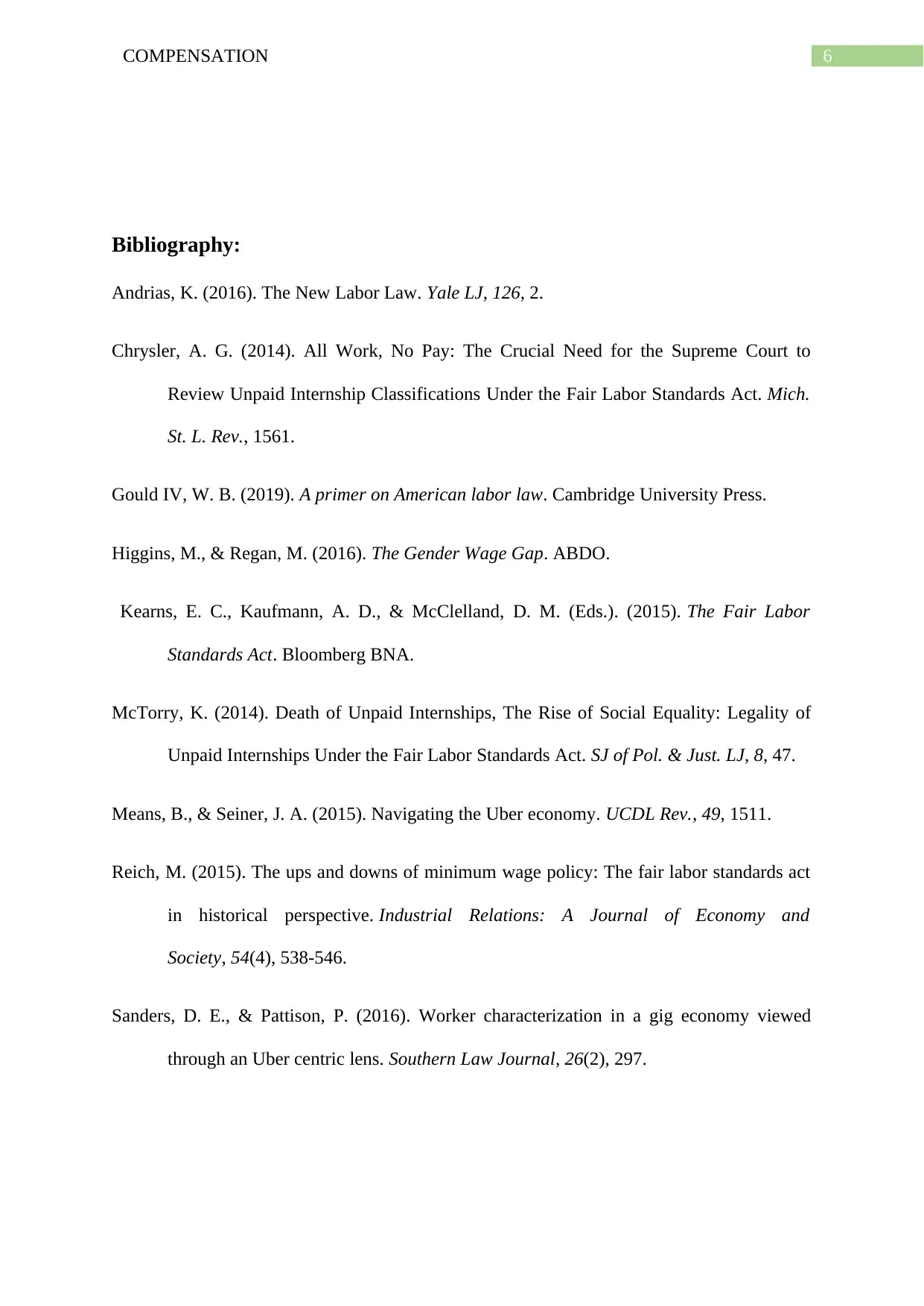
6COMPENSATION
Bibliography:
Andrias, K. (2016). The New Labor Law. Yale LJ, 126, 2.
Chrysler, A. G. (2014). All Work, No Pay: The Crucial Need for the Supreme Court to
Review Unpaid Internship Classifications Under the Fair Labor Standards Act. Mich.
St. L. Rev., 1561.
Gould IV, W. B. (2019). A primer on American labor law. Cambridge University Press.
Higgins, M., & Regan, M. (2016). The Gender Wage Gap. ABDO.
Kearns, E. C., Kaufmann, A. D., & McClelland, D. M. (Eds.). (2015). The Fair Labor
Standards Act. Bloomberg BNA.
McTorry, K. (2014). Death of Unpaid Internships, The Rise of Social Equality: Legality of
Unpaid Internships Under the Fair Labor Standards Act. SJ of Pol. & Just. LJ, 8, 47.
Means, B., & Seiner, J. A. (2015). Navigating the Uber economy. UCDL Rev., 49, 1511.
Reich, M. (2015). The ups and downs of minimum wage policy: The fair labor standards act
in historical perspective. Industrial Relations: A Journal of Economy and
Society, 54(4), 538-546.
Sanders, D. E., & Pattison, P. (2016). Worker characterization in a gig economy viewed
through an Uber centric lens. Southern Law Journal, 26(2), 297.
Bibliography:
Andrias, K. (2016). The New Labor Law. Yale LJ, 126, 2.
Chrysler, A. G. (2014). All Work, No Pay: The Crucial Need for the Supreme Court to
Review Unpaid Internship Classifications Under the Fair Labor Standards Act. Mich.
St. L. Rev., 1561.
Gould IV, W. B. (2019). A primer on American labor law. Cambridge University Press.
Higgins, M., & Regan, M. (2016). The Gender Wage Gap. ABDO.
Kearns, E. C., Kaufmann, A. D., & McClelland, D. M. (Eds.). (2015). The Fair Labor
Standards Act. Bloomberg BNA.
McTorry, K. (2014). Death of Unpaid Internships, The Rise of Social Equality: Legality of
Unpaid Internships Under the Fair Labor Standards Act. SJ of Pol. & Just. LJ, 8, 47.
Means, B., & Seiner, J. A. (2015). Navigating the Uber economy. UCDL Rev., 49, 1511.
Reich, M. (2015). The ups and downs of minimum wage policy: The fair labor standards act
in historical perspective. Industrial Relations: A Journal of Economy and
Society, 54(4), 538-546.
Sanders, D. E., & Pattison, P. (2016). Worker characterization in a gig economy viewed
through an Uber centric lens. Southern Law Journal, 26(2), 297.
1 out of 7
Related Documents
Your All-in-One AI-Powered Toolkit for Academic Success.
+13062052269
info@desklib.com
Available 24*7 on WhatsApp / Email
![[object Object]](/_next/static/media/star-bottom.7253800d.svg)
Unlock your academic potential
Copyright © 2020–2025 A2Z Services. All Rights Reserved. Developed and managed by ZUCOL.




